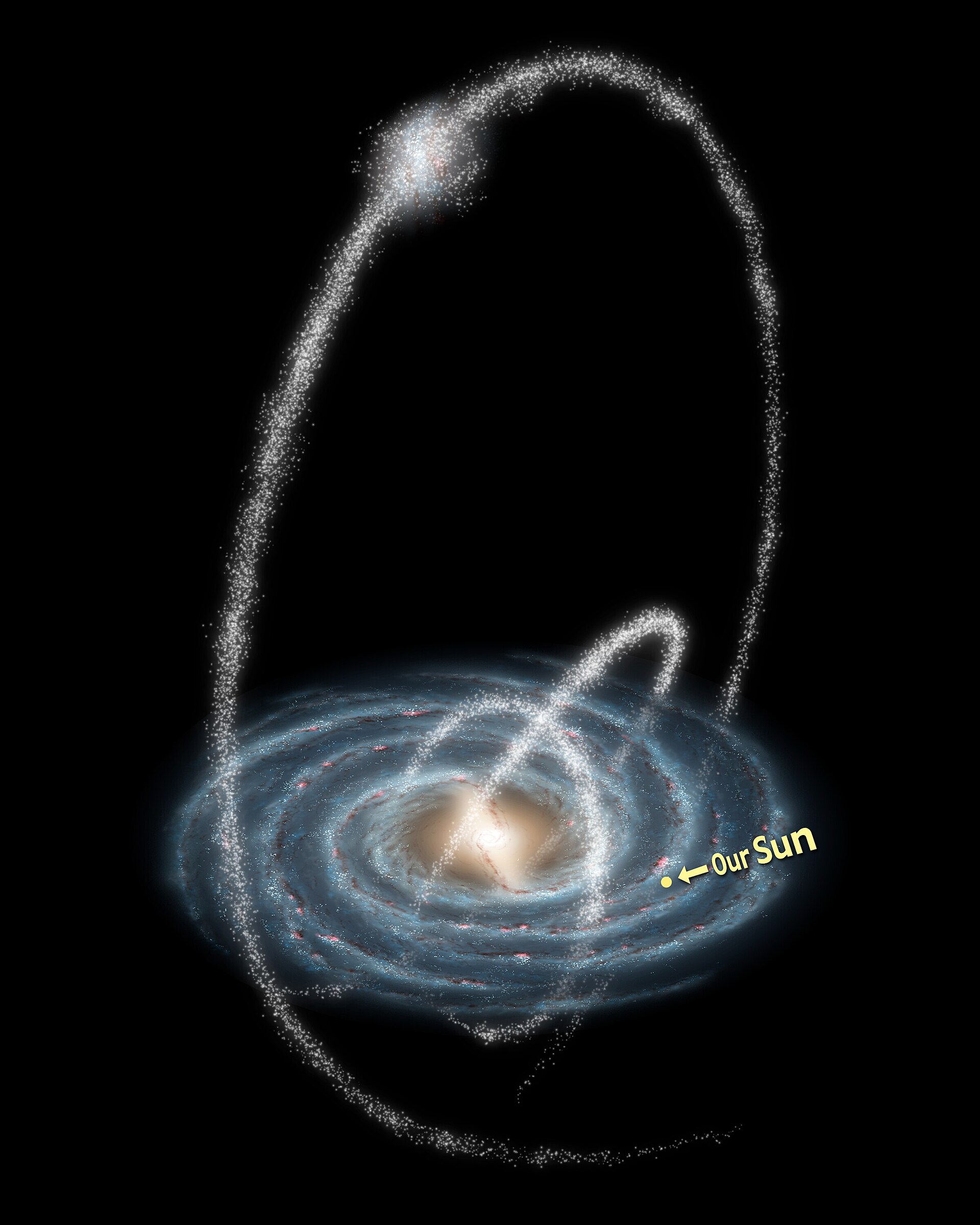Modern astronomy claims that all large galaxies, including our Milky Way, were formed by absorbing smaller galaxies or star clusters. This means that some globular clusters that are now in our galaxy are probably left over from other galaxies. These galaxies were subsequently absorbed by the Milky Way or possibly pulled out of independent satellite galaxies, such as the Magellanic Clouds.

Tidal streams
The Milky Way is home to a large number of satellite galaxies, among them the famous Magellanic Clouds and lesser-known ones, such as the dwarf galaxy in the constellation Fornax (Fornax Dwarf) and the dwarf galaxy Antlia 2 (Antlia II Dwarf). But not all of these dwarf galaxies are completely independent. Some of them, such as the spherical Sagittarius Dwarf Galaxy, turn out to be noticeably elongated or distorted — they have a shape more like streams of stars than organized galactic structures. This indicates that they are now under the gravitational influence due to the process of merging with the Milky Way.

The discovery of these tidal streams contributed to the solution of a mysterious observation: many globular clusters surrounding our galaxy have a similar age, while others are relatively young. Astronomers suggested that this was possible due to the fact that these young clusters were formed by relatively young dwarf galaxies. Over time, more and more evidence has been collected to support this argument.
“Stealing” clusters
In 2002, astronomers studying the globular cluster NGC 5634 noticed that it was moving in the tidal stream of the Sagittarius Dwarf Galaxy. Its motion and relatively low metal content also corresponded to other features of a dwarf galaxy.
Since then, astronomers have found convincing evidence that several additional spherical clusters are also associated with this galaxy, which suffers from tides. They include AM 4, Arp 2, Pal 12, NGC 2419, NGC 4147, Terzan 7, Terzan 8, Whiting 1. At the same time, other streams of torn dwarf galaxies were discovered, such as the Helmi stream, Gaia-Enceladus and others.
Astronomers also believe that some of the less damaged dwarf galaxies orbiting the Milky Way could have made an important contribution to the formation of spherical clusters, and perhaps even “steal” some of them.
Simulation of “stealings”
In recent studies, scientists applied a different approach. Namely, they examined how various galaxies surrounding the Milky Way and being absorbed by it could exchange spherical clusters. In their first article, they created models of hypothetical dwarf galaxies in different orbits around the Milky Way to study how easily their clusters could be separated from their host galaxies.
They concluded that the percentage of clusters that could be separated ranged from 12% to 93%. The chances of cluster separation would be higher if they had elliptical orbits that brought them into the vicinity of their host galaxies. But, if the galaxy were more massive, it could better hold its clusters.

Based on these simulations, the authors of the articles suggested that at least two globular clusters could originate from a dwarf galaxy in the constellation Fornax, four from the Large Magellanic Cloud, two from the Small Magellanic Cloud and 14 from the spherical Sagittarius Dwarf Galaxy.
In their second study, they approached the issue differently, studying the orbital properties of 154 globular clusters and comparing them with the characteristics of 41 dwarf galaxies orbiting the Milky Way, as well as some tidal streams.
Using only these characteristics, the authors identified 14 globular clusters associated with the spherical Sagittarius Dwarf Galaxy, which confirmed the results of previous studies. However, their findings do not coincide with other studies on the origin of these clusters. Five clusters, which the authors previously considered to be associated with the Sagittarius Dwarf Galaxy, did not have sufficient parameters to be considered “stolen”.
Inaccuracies in simulations
Nevertheless, they identified four new globular clusters that were not previously associated with the galaxy. However, they have a high probability of being associated with it, as well as six others with a lower probability. The study also identified six clusters that likely originated from the Large Magellanic Cloud. In general, their work shows that 29 (19%) of the known globular clusters have characteristics that are quite similar to dwarf galaxies and indicate their origin from them.
The authors admit that their models are somewhat simplified, since they do not fully reproduce the complex three-dimensional structure of dwarf galaxies.
Earlier we reported on how a special feature of the Milky Way could impress extraterrestrial astronomers.
According to universetoday.com
Follow us on Twitter to get the most interesting space news in time
https://twitter.com/ust_magazine

